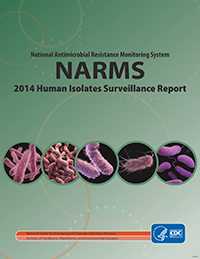Annual Reports and Interactive Data
NARMS Now: Human Data
See how antibiotic resistance for four bacteria transmitted commonly through food has changed over the past two decades.
The NARMS Annual Reports summarize antimicrobial resistance among enteric bacteria. The Annual Reports describe the number and type of isolates collected, their associated antimicrobial resistance, and trends in antimicrobial resistance. These four reports, the Human Isolates Report (CDC), the Retail Meat Isolates Report (FDA), the Interagency Executive Report (FDA), and the Animal Isolates Report (USDA), are published yearly. This web page contains CDC NARMS Annual Human Isolates Reports dating back to 1997.
Laboratory Testing and Isolate Submissions
The CDC NARMS laboratory conducts antimicrobial resistance testing on isolates from sporadic cases and outbreaks of illness. The lab also confirms and studies bacteria that have new antimicrobial resistance patterns and performs research to understand the mechanisms of resistance and how they are spread. More
2014 NARMS Annual Human Isolates Report
 Find out what’s new in the 2014 report
Find out what’s new in the 2014 report
- Read the 2014 Annual Human Isolates Report [PDF – 83 pages, 1.88 MB]
- This annual report includes CDC’s surveillance data for 2014 for non-typhoidal Salmonella (refers to serotypes not causing typhoid fever), typhoidal Salmonella (serotypes Typhi, Paratyphi A, Paratyphi B [tartrate negative], and Paratyphi C), Shigella, Campylobacter, E. coli O157, and Vibrio species other than V. cholerae.
- Surveillance data include the number of isolates of each bacteria tested by NARMS and the number and percentage of isolates that were resistant to each of the antimicrobials tested. Data for earlier years are presented in tables and graphs when appropriate.
NARMS Annual Human Isolates Reports
- 2014 [PDF – 83 pages, 1.88 MB]
- 2013 [PDF – 81 pages, 9.77 MB]
- 2012 [PDF – 88 pages, 1.47 MB]
- 2011 [PDF – 71 pages, 1.46 MB]
- 2010 [PDF – 75 pages, 2.69 MB]
- 2009 [PDF – 75 pages, 16.9 MB]
- 2008 [PDF – 78 pages, 1.59 MB]
- 2007 [PDF – 66 pages, 2.75 MB]
- 2006 [PDF – 69 pages, 2.29 MB]
- 2005 [PDF – 78 pages, 1.18 MB]
- Page last reviewed: August 19, 2015
- Page last updated: August 26, 2016
- Content source:



 ShareCompartir
ShareCompartir